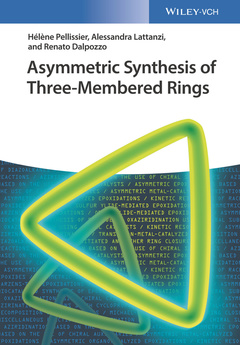Asymmetric Synthesis of Three-Membered Rings
Auteurs : Pellissier Hélène, Lattanzi Alessandra, Dalpozzo Renato

The outstanding and experienced authors have an excellent international reputation and cover cyclopropanes, epoxides and aziridines as well as chiral oxaziridines in equal measure. To this end, they describe in detail different synthetic approaches starting with chiral substrates as well as the application of chiral metal- or organocatalysts. Furthermore, methods for the kinetic resolution of initially racemic products are treated alongside recent advances and novel developments in established techniques for the synthesis of three-membered rings.
With its structured composition this is of high interest to scientists in methodological and natural product synthesis as well as those in industrial and pharmaceutical chemistry.
Preface ix
List of Abbreviations xi
1 Asymmetric Cyclopropanation 1
1.1 Introduction 1
1.2 Simmons–Smith Cyclopropanation 2
1.2.1 Chiral Substrates 3
1.2.1.1 Chiral Allylic Alcohols 3
1.2.1.2 Chiral Allylic Amines 7
1.2.1.3 Chiral Acetal-Directed Cyclopropanations 7
1.2.1.4 Simple Chiral Alkenes 9
1.2.2 Chiral Auxiliaries 11
1.2.3 Chiral Catalysts 15
1.2.3.1 Charette’s Ligand 15
1.2.3.2 Other Stoichiometric Ligands 20
1.2.3.3 Walsh’ Procedure 22
1.2.3.4 True Catalytic Procedures 24
1.3 Transition-Metal-Catalyzed Decomposition of Diazoalkanes 27
1.3.1 Intermolecular Cyclopropanation 28
1.3.1.1 Chiral Auxiliaries 28
1.3.1.2 Chiral Catalysts: Cobalt 32
1.3.1.3 Chiral Catalysts: Copper 38
1.3.1.4 Chiral Catalysts: Rhodium 56
1.3.1.5 Chiral Catalysts: Ruthenium 69
1.3.1.6 Chiral Catalyst: Other Metals 77
1.3.2 Intramolecular Cyclopropanation 80
1.3.2.1 Chiral Auxiliaries and Chiral Compounds 80
1.3.2.2 Chiral Catalysts 82
1.3.3 Chiral Stoichiometric Carbenes 93
1.4 Michael-Initiated and Other Ring Closures 94
1.4.1 Chiral Substrates 95
1.4.2 Chiral Auxiliaries 100
1.4.2.1 Chiral Michael Acceptors 100
1.4.2.2 Chiral Nucleophiles 106
1.4.3 Organocatalysis 115
1.4.3.1 Ylides 116
1.4.3.2 Nitrocyclopropanation 118
1.4.3.3 Halocarbonyl Compounds 128
1.4.4 Metal Catalysis 139
1.4.5 Other Ring Closures 140
1.5 Miscellaneous Reactions 148
1.5.1 Rearrangement of Chiral Oxiranes 148
1.5.2 Cycloisomerization of 1,n-Enynes 152
1.5.3 Denitrogenation of Chiral Pyrazolines 160
1.5.4 C–H Insertion 162
1.5.5 Addition to Cyclopropenes 164
1.5.6 Other Methods 167
1.6 Conclusions 172
References 172
2 Asymmetric Aziridination 205
2.1 Introduction 205
2.2 Aziridination Based on the Use of Chiral Substrates 206
2.2.1 Addition to Alkenes 206
2.2.1.1 Aziridination via Nitrene Transfer to Alkenes 206
2.2.1.2 Aziridination via Addition–Elimination Processes 219
2.2.1.3 Miscellaneous Reactions 224
2.2.2 Addition to Imines 225
2.2.2.1 Methylidation of Imines 226
2.2.2.2 Aza-Darzens and Analogous Reactions 248
2.2.2.3 Addition/Elimination Processes 255
2.2.2.4 Miscellaneous Reactions 266
2.2.3 Addition to Azirines 267
2.2.4 Aziridination via Intramolecular Substitution 270
2.2.4.1 From 1,2-Amino Alcohols 270
2.2.4.2 From 1,2-Amino Halides 278
2.2.4.3 From 1,2-Azido Alcohols 282
2.2.4.4 From 1,2-Amino Sulfides and 1,2-Amino Selenides 285
2.2.4.5 From Epoxides 286
2.2.5 Miscellaneous Reactions 287
2.3 Aziridination Based on the Use of Chiral Catalysts 296
2.3.1 Aziridination via Nitrene Transfer to Alkenes 296
2.3.1.1 Cu-Catalyzed Aziridination 296
2.3.1.2 Rh-Catalyzed Aziridination 310
2.3.1.3 Ru-Catalyzed Aziridination 312
2.3.1.4 Catalysis by Other Metals 314
2.3.1.5 Organocatalyzed Aziridination 318
2.3.2 Aziridination via Carbene Transfer to Imines 332
2.3.2.1 Carbene Methodology 332
2.3.2.2 Sulfur-Ylide-Mediated Aziridination 350
2.3.3 Miscellaneous Reactions 353
2.3.4 Kinetic Resolutions of Aziridines 357
2.4 Conclusions 363
References 364
3 Asymmetric Epoxidation 379
3.1 Introduction 379
3.2 Asymmetric Epoxidations Based on the Use of Chiral Auxiliaries 380
3.3 Asymmetric Metal-Catalyzed Epoxidations 381
3.3.1 Ti-, Zr-, Hf-Catalyzed Epoxidations 381
3.3.2 V-, Nb-, Ta-Catalyzed Epoxidations 391
3.3.3 Cr-, Mo-, W-Catalyzed Epoxidations 397
3.3.4 Mn-, Re-, Fe-, Ru-Catalyzed Epoxidations 400
3.3.5 Pt-, Zn-, Lanthanoid-Catalyzed Epoxidations 412
3.4 Asymmetric Organocatalyzed Epoxidations 419
3.4.1 Phase-Transfer Catalyst 419
3.4.2 Polyamino Acids and Aspartate-Derived Peracids 423
3.4.3 Chiral Dioxiranes, Iminium Salts, and Alkyl Hydroperoxides 431
3.4.4 Chiral Amines 447
3.5 Kinetic Resolution of Racemic Epoxides 468
3.6 Asymmetric Sulfur-Ylide-Mediated Epoxidations 480
3.7 Asymmetric Darzens-Type Epoxidations 489
3.7.1 Chiral Auxiliary- and Reagent-Mediated Darzens Reactions 489
3.7.2 Catalytic Asymmetric Darzens Reactions 492
3.8 Other Ylide-Mediated Epoxidations 503
3.9 Asymmetric Biocatalyzed Synthesis of Epoxides 505
3.10 Conclusions 512
References 514
4 Asymmetric Oxaziridination 539
4.1 Introduction 539
4.2 Oxaziridination Using Chiral Substrates 540
4.3 Oxaziridination Using Chiral Catalysts 544
4.4 Kinetic Resolutions 551
4.5 Conclusions 554
References 555
5 Asymmetric Azirination and Thiirination 559
5.1 Introduction 559
5.2 Asymmetric Azirination 559
5.2.1 Neber Approaches 560
5.2.2 Elimination Approaches 565
5.2.3 Other Approaches 569
5.3 Asymmetric Thiirination 570
5.3.1 Conversion of Epoxides 571
5.3.2 Condensation of Sulfur]Stabilized Carbanions to Carbonyl Compounds 572
5.3.3 Intramolecular Nucleophilic Substitution 574
5.3.4 Miscellaneous Reactions 576
5.4 Conclusions 577
References 579
Index 583
Alessandra Lattanzi obtained the national Italian habilitation for Full Professor in organic chemistry in 2013 at the University of Salerno (Italy) and received her MSc and PhD from University of Rome "La Sapienza" (Italy). From 1999 to 2000 she was a visiting scientist in Prof. V. K. Aggarwal's group in Sheffield (UK). In 2005, she was promoted to Associate Professor at the University of Salerno. She has authored over 95 publications including reviews in international journals, 12 book chapters in the areas of stereoselective synthesis of heterocyclic compounds and oxidation reactions.
Starting in 1983, Renato Dalpozzo was a Researcher of Organic Chemistry at the University of Bologna (Italy). In 1992, he moved to the University of Calabria (Italy) as Associate Professor of Organic Chemistry and then as Full Professor of Organic Chemistry. For ten years he was also full Professor of Environmental and Cultural Heritage Chemistry. He has authored over 110 publications and a book chapter in the areas of the reactivity of organometallic compounds with aromatic systems, the use of dianions derived from enamino carbonyl compounds, the stereoselective reduction of various classes of ketones, the development of new Lewis acid systems, and enantioselective organocatalysis. He authored also a text book for students of his University.
Date de parution : 06-2017
Ouvrage de 608 p.
17.5x24.9 cm
Disponible chez l'éditeur (délai d'approvisionnement : 14 jours).
Prix indicatif 185,98 €
Ajouter au panierThème d’Asymmetric Synthesis of Three-Membered Rings :
Mots-clés :
cyclopropane, epoxide, aziridine, oxaziridine, cyclization, Simmons-Smith, MIRC, kinetic resolution, Darzens reaction, azirine, thiirane, catalysis



